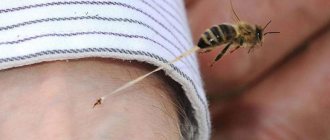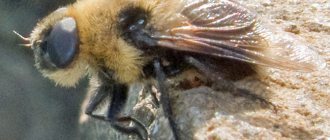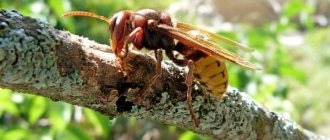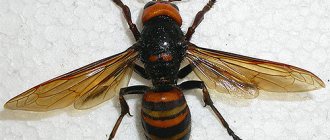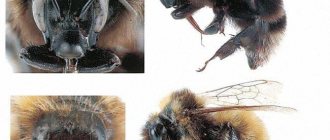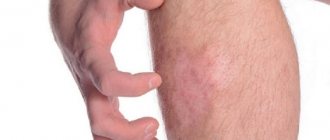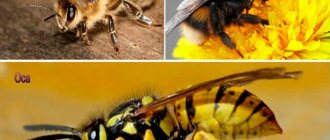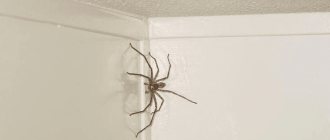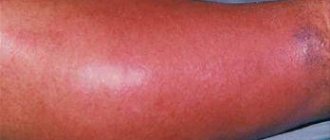Lifestyle of hornet and wasp. Appearance of insects - size, body anatomy, sting. Danger of poison to humans. Construction of a wasp and hornet nest. Symptoms that accompany the bite. Health care. Allergy to the bite.
Hymenoptera are a large order of insects that include many species and genera. People often confuse them with each other, so you need to figure out how a hornet and a wasp differ, understand their appearance, danger, lifestyle and reproduction. Knowing the details, you can protect yourself from stinging hymenoptera.
Main differences
Entomologists have devoted many years to studying these types of insects, so now you can easily understand the differences between wasps, hornets, and bumblebees. The first, and most important, difference is the size. The hornet is the largest when compared with all social wasps - a subfamily group that uses paper during construction.
But size is not the only difference. It is also worth mentioning the difference in pigmentation. An ordinary wasp is characterized by a classic yellow color, while a hornet is darker, most often brown. There are also differences in the caliber of the tip. Despite the fact that hornets are not the largest representatives of Hymenoptera, they do not use their stings as often as wasps, since they are less aggressive in nature.
How are they different from a bumblebee?
People without zoological education confuse hornets not only with wasps, but also with bumblebees. They do not understand how a hornet differs from a bumblebee.
Entomologists highlight the following points::
- Hornets are close to wasps, and bumblebees are close to the honey bee.
- Bumblebees are quite large (the female is 1.3-2.8 cm, and the male is 0.7-2.4 cm), but hornets are larger than them.
- Bumblebees are usually yellow and black, often striped. In addition, there are bumblebee species with red or orange stripes, and some species are solid black. In addition, their body is furry.
- Bumblebees and hornets are social insects. But both species go out in search of food alone. Bumblebees try to collect nectar before other Hymenoptera, which are still in the sleep stage.
Compared to hornets, bumblebees are less prone to conflict. Having understood how each representative of the Hymenoptera differs, a person will be able to clearly understand who is in front of him. This will help them act correctly to avoid being stung.
Lifestyle
The hornet and the wasp are social insect species. Socialized Hymenoptera increases the population through the laying of eggs by the queen, which can reproduce more than two thousand workers in one fertilization. They are busy building nests. The activity of members of the family depends on the time of year.
When it comes to what differentiates wasps from bees, they do not produce honey, and their feeding method differs depending on the species.
Wasp diet:
- In the summer, they consume flower nectar, bee honey, fruit juice, vegetables, and berries. Sweets and rotten foods are also considered delicacies;
- They are greedy for kvass, lemonades, fruit and vegetable juices, jams, syrups;
- Often, predators attack a bee family, destroying the hives in just 2 hours. They consume the honey themselves, and take the bees to feed the larvae.
Hornets hunt smaller representatives of insects - wasps, flies, caterpillars.
Preparing for winter
In the fall, they scatter around the surrounding area and after that they no longer show their former activity and become much more vulnerable, sleepy and inactive. The fate of each individual individual develops differently. Some of them simply live out their lives as summer ends. After that they freeze.
If we are talking about fertile and fairly young females, then they usually mate at the very end of August, and then simply sleep in a secluded corner. This is necessary in order to continue life after the onset of spring (with the onset of heat). At the end of the season, the males die, as well as the working females and the old queen. It also happens that fertile females are born only at the very end of the season.
Another circumstance that has a strong impact on the situation with these insects is the slowdown of metabolic processes in the body of the uterus. After this, preparations for wintering begin. The body temperature of these insects begins to drop to a minimum level, which will help cope with freezing on too cold winter days. Wasps in winter are able to withstand even the harshest conditions if they manage to find a secluded place.
Differences in appearance, photos
In appearance, the insects are quite similar, but differ in size. The queen hornet reaches a length of about 4-5 centimeters, the working individual and the male are slightly shorter. Common wasps are on average comparable to other Hymenoptera species. The working individual reaches 1.2–1.4 centimeters in length, the female – 1.8 centimeters.
In addition, it is necessary to say about the differences in color and other features. Small wasps do not have a shade of brown on their bodies - their colors are predominantly yellow and black. Large relatives are characterized by the presence of a brown tint, most often in the cephalothorax area.
The two representatives are distinguished by their characteristic thin waist, powerful jaws and large visual organs, but there are differences in the size and shape of the head. The hornet has an almost round shape and a wide nape, the wasp is small in size and has a narrowed shape near the base.
Nest construction
The presented insects construct similar hives. The main difference is the color. The wasp family builds gray cocoons, while the hornet family builds brownish ones. Rotten wood and birch bark are used as construction materials.
The housing structure of the Hymenoptera is characterized by its multi-tier structure and oval shape. The population size is affected by the size of the hive. Regarding the location of the nest, it is impossible to distinguish wasps from hornets, since one prefers the same locations - old cavities in tree trunks, bird nests, the roof and attic of a human house.
Vespiary
Wasps independently obtain building material. It is an old stump, a tree, a fence, various buildings made of wood - this affects the gray tint of the hive. When a suitable material is found, the insect begins to moisten it with its own saliva, after which it scrapes off the thin wood fibers. Powerful jaws are used to collect a sufficient amount of building material.
Having made preliminary preparations, the stingers go to the place where the construction of the cocoon is planned. Next, the lumps are once again processed using the jaws and generously moistened with sticky secretion. Afterwards, the process of forming the cells of the hive begins - strips of material are rolled out perpendicularly, as a result - the formation of a thin paper cell wall, over time a complete housing is obtained.
Hornet's nest
Hornet also has excellent construction skills. They form their nest using rotten wood, which is first chewed and moistened with saliva. The resulting building material is used to create honeycombs and the frame of the hive; saliva is used as glue. The dried frame is similar in appearance to corrugated paper. The shade is usually brown, but can vary as different types of wood are used.
This large stinger will never use its nest next year. After wintering, the queen looks for a comfortable place to start building a new home. A “leg” is attached to the base, to which the first honeycomb cells are attached.
Cocoons grow from top to bottom. The number of tiers gradually increases, as well as the formation of a multilayer shell. Depending on the number of layers laid, one can guess the size of the population living in this hive. The design is characterized by a shell of up to 8 centimeters, thanks to which the larvae are protected from summer heat, sudden temperature changes and strong winds.
Where do wasps and hornets spend the winter?
Over the summer, wasps accumulate a large amount of nutrients and hibernate in the winter, using their body's reserves. Single individuals can overwinter under tree bark, in tree hollows, in old destroyed stumps, and in crevices of outbuildings. Over the summer, a swarm can build a huge “paper” nest, but with the onset of autumn, the young generation must seek shelter for the winter and not return to the old nest.
During warm days, hornets build a nest, raise young animals and accumulate nutrients for wintering. In early autumn, young females fly out of the nest to look for a partner. After fertilization, they nest in crevices for wintering. With the onset of cold weather, worker hornets close the exits from the nest and can feed on supplies and eggs that are laid throughout the season.
Hornets' homes are structures made of paper, which they make from the young bark of trees.
In severe frosts, the worker hornets die, leaving only the queen in the nest, who will lay new eggs in the spring and create a new swarm. Wintering is a suspended animation sleep until early spring. With the first positive heat reading, the female wakes up and looks for a place to build a nest where she will lay eggs and hatch a new colony of hornets. Insects are considered an endangered species and are listed in the Red Book.
Human interaction
Many people have encountered wasp bites - this is a rather aggressive insect that attacks almost immediately if they sense a dangerous situation. The hornet is less aggressive towards people, but will attack if there is danger for itself, family or nest.
Lesser Hymenoptera often flies into human possession because they are attracted to food supplies. They easily enter residential buildings and apartments through an open window, but will bite if threatened.
Attacks by a whole swarm are very dangerous for people. A wasp can sting up to three times in a minute, sticking its sting under the skin of a person, they inject poison. If a large amount of a toxic substance enters the bloodstream at the same time, the human body can react unpredictably, the consequences will be especially severe for allergy sufferers.
If we talk about hornet behavior, it is influenced by taste preferences. They prefer sweet foods - honey, sugar, fruits, berries. But relative to humans, they are not so aggressive. An attack is carried out only if there is a presentiment of real danger. To feed the larvae, they catch insects, caterpillars, and spiders.
Comparing the bites of two stinging ones, the second ones sting not so painfully, but there is still a risk of an allergic reaction with difficult consequences. The victim experiences swelling, hyperemia of the bitten skin, pain, and a local increase in temperature. Allergy sufferers experience nausea, vomiting, general loss of energy and breathing problems.
What to do if bitten by a stinging insect
Many people do not know what to do if they are bitten by a member of the wasp family. When severe pain occurs, you can understand that the body is undergoing destruction. It is necessary to understand that the poison contains toxins that have a strong effect on the nerve endings, which is why the pain shock is very pronounced.
In normal situations, it is difficult to imagine the consequences of an attack because everyone reacts differently. Some may get by with only pain and swelling, while others may face dire consequences, including asphyxia, loss of consciousness, and even death.
It is very important not to hesitate and immediately provide first aid:
- Remember the main rule - there will be no sting in the wound, only poison, so there is no need to look for it and try to squeeze it out.
- Try to remove the toxic substance by sucking it out.
- Treat the affected area of the skin with citric or acetic acid.
- Try washing the wound with soapy water.
- Treat the wound with a solution that contains alcohol; you can also use hydrogen peroxide.
- Apply something cold and wet sugar to the wound - this will reduce the rate at which toxins spread through the blood.
- Do not drink alcohol if you are bitten - this will increase swelling and worsen the general condition of the victim. Attacks to the neck and head area are especially dangerous.
- If you take into account folk remedies, you can use dandelion juice, plantain juice, and soda solution. A slice of onion and garlic works great.
Symptoms of an allergic reaction are accompanied by:
- Severe headache;
- Increased body temperature;
- Rapid heartbeat;
- Heavy breathing;
- Abdominal pain.
If the above induced symptoms occur, the victim should take a pain reliever tablet to reduce the effects of histamine. You should also drink plenty of water to reduce poisoning.
Remember that if there is no improvement in your condition, consult a doctor immediately.
Can bees harm you?
Most of them can. “Bee stings typically result in pain and a localized reaction of mild swelling, redness and itching at the site of the sting,” says Troiano. “However, for a person who is allergic to bee stings, even one sting can be life-threatening.”
When a bee stings you, its stinger detaches and continues to pump you full of venom until you remove it, which is not very pleasant. The pain does not last forever, but the bite usually causes swelling and itching.
It's worth noting that honey bees usually die after stinging a person, and ground bees are not aggressive, so the chances of being stung by one are low.

